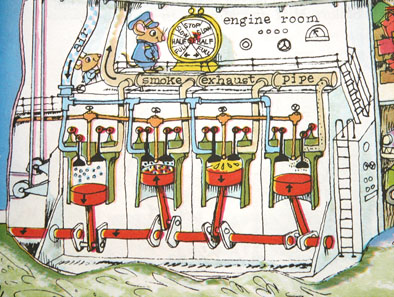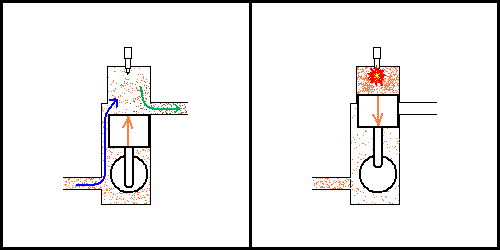
Figure 32-1: The cycles of the four-cycle engine.
Image from Scarry, Richard (1976). Richard Scarry's What Do People Do All Day? New York: Random House
| NAME | DATE |
A hovercraft converts power from the engine to lift and thrust, but how does it produce the power in the first place? Different hovercraft use different kinds of engines, from the electric fan and leaf blower engines on rudimentary craft built as a project in the backyard to the engines on large military and commercial hovercraft – diesel engines and jet turbine engines that can produce thousands of horsepower. Most light hovercraft use gasoline-powered internal combustion engines. There are two kinds of internal combustion engines in common use: two-cycle and four-cycle.
Two-cycle and four-cycle engines both operate on the principle of the Otto Cycle, which has four stages: (1) intake of fuel and air; (2) compression of the fuel-air mixture; (3) combustion of the fuel (the power stroke); and (4) release of the exhaust from the combustion process.

Figure 32-1: The cycles of the four-cycle engine.
Image from Scarry, Richard (1976). Richard Scarry's What Do People Do All Day? New York: Random House
We begin by describing the four-cycle engine, since it follows most closely the steps of the Otto cycle and because the DiscoverHover One hovercraft calls for a four-cycle engine. In the first stroke of the engine, the piston moves down in the cylinder and the intake valve opens. When the piston moves down, it creates a partial vacuum in the cylinder, and the mixture of fuel vapor and air flows in to fill that void. Next, the intake valve closes and the piston moves up, compressing the mixture. Once the mixture is compressed, the spark plug fires, causing the mixture to combust. A rapid chemical reaction occurs, which generates a great deal of heat. This heat causes the compressed gas to expand, forcing the piston back down. This provides the power for the engine. Finally, the exhaust valve opens and the piston moves back up to expel the burned remnants of the fuel.

Figure 32-2: The cycles of the two-cycle engine
Image ©2005 DiscoverHover
The two-cycle engine goes through the four stages of the Otto cycle in just two steps, referred to as cycles or strokes. In one step, the piston moves up, lowering the pressure below it and raising the pressure above it. This causes the vaporized mixture of fuel and air to flow into the intake valve which is connected below the piston in an area called the crank case. Also, the upward motion of the piston compresses the fuel-air mixture. In the second stroke, the compressed mixture combusts, driving the piston down and releasing the exhaust.
The two-cycle engine is often used in chainsaws, outboard motors, small motorcycles, as well as in most racing and light hovercraft because, compared to the four-cycle engine, it has few moving parts, can operate in any orientation, and can put out a large amount of power for its weight. Unlike the four-stroke engine, it burns fuel and produces power on every stroke instead of every other stroke. However, the two-cycle engine produces a lot of noise and pollution and is not very efficient. As you can see, since it releases the burned material and takes in the fuel at the same time, some of the fuel makes it through and escapes with the exhaust. This is not all bad because some of this fuel evaporates inside the engine and in so doing helps to cool the motor. Another fact to consider is that fuel is stored in the crankcase part of the time, so oil is mixed in with the fuel. Oil is mixed with the fuel in the power stroke as well, so it burns when the fuel burns, and burning oil creates lots of carbon particles. The oil is also vital to internal engine lubrication.
We understand now how the engine works. Turning our attention to the source of the spark that ignites the fuel, we see that many small engines use a device called a magneto to provide this spark. Magnetos provide a highly reliable way to send a burst of thousands of volts through the spark plug exactly when it is needed. A magneto is a combination of a dynamo, a contact breaker, and a coil. The part that functions like a dynamo uses the principle of electromagnetic induction, which was discovered in 1831 by Michael Faraday (detailed in Curriculum Guide #29).
In a magneto, a permanent magnet is attached to the engine so that when the engine spins, the magnet rotates inside the coil of wire. This causes an electric current to flow through the coil. The coil in a magneto is actually two coils with an electrical insulator between them. One coil consists of approximately 200 turns of relatively thick copper wire; the second coil consists of approximately 10 000 turns of thinner copper wire. With every revolution, a cam attached to the engine triggers the contact breaker, which is a kind of switch. The contact breaker interrupts the current flowing through the first coil. Remember that a current flowing through a coil produces a magnetic field – when the current is flowing through the main coil, it causes a magnetic field over an area that includes the second coil. This magnetic field builds up, and then, when the contact breaker cuts off the current, it disappears very fast. Now we come back to Faraday’s Law, this time on the second coil. We have a strong magnetic field changing very quickly across a coil with thousands of turns. This produces a voltage in the thousands of volts for a very short time, enough to put a spark across the gap of the spark plug, igniting the fuel. If this happens at just the right time, the engine will run smoothly and efficiently. This is often accomplished using a device known as a distributor, which has a cable in the center that carries the high-voltage energy to a rotating arm (a rotor), which carries the signal past a series of electrical contacts equal to the number of cylinders in the engine. There is always a means provided on an engine to adjust the timing of when the spark fires to the speed of the motor. Without this addition, an engine will not run smoothly, nor will it generate its maximum potential power output.

Figure 32-3: The distributor, rotor and contact points for a four-cylinder engine.
Image ©2005 DiscoverHover
Quiz Questions:
| ©2005 World Hovercraft Organization All rights reserved. Copies of this Curriculum Guide may be printed for classroom use exclusively by DiscoverHover registered members. This Curriculum Guide and all materials contained in the DiscoverHover web site are protected by copyright laws and may not be reproduced, republished, distributed, or displayed on any other web site without the express prior written permission of the World Hovercraft Organization. |